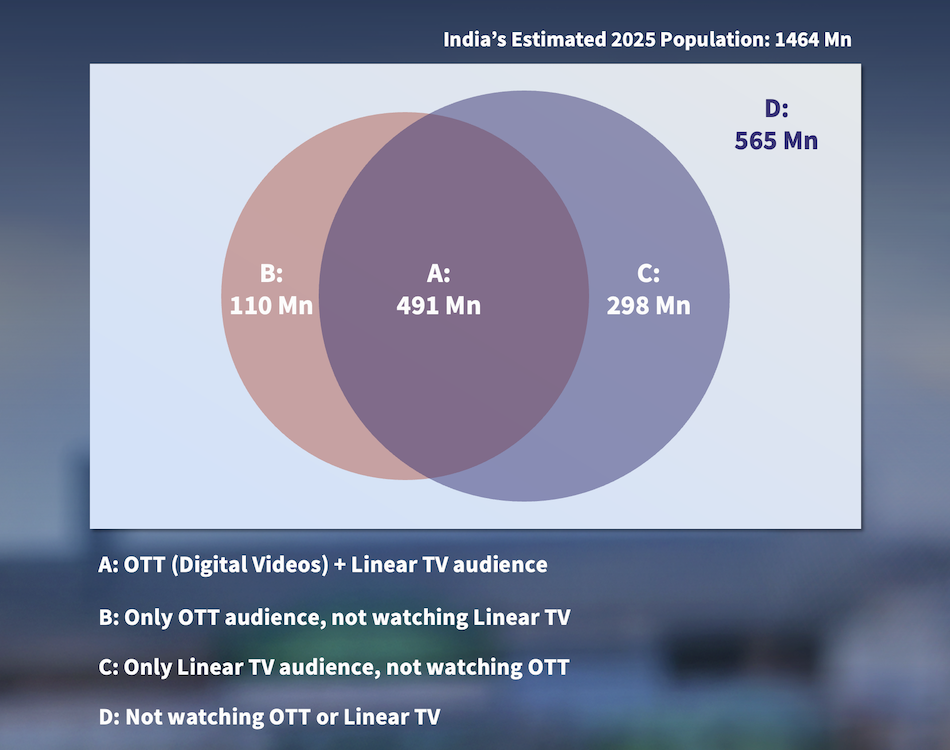


By Our Insights Desk
The Indian media landscape is a complex one, and the intersection of various audience types can often be confusing, even for those who have spent many decades in the business. We are often asked questions in this direction, such as: What percentage of pay audiences on streaming also visit movie theatre? What is the overlap between TV and digital? Do audiences watch sports only on TV or OTT, or do they often switch between the two modes of consumption? Is there an overlap of audiences on OTT between the various South Indian languages?
Over the years, Ormax Media has been publishing industry reports and data to address such questions. We are now starting a new series called Venn It Happens, in which we will periodically publish Venn diagram illustrations on how various audience types in the Indian media market intersect.
The first edition of Venn It Happens looks at the intersection between the OTT and Linear TV audience universes in India.

Data from this infographic has been sourced from The Ormax OTT Audience Report: 2025, our annual industry report to size and profile the OTT audience base in India.
A+B+C+D is the total estimated population of India in 2025. A+B is the 601 million OTT audience base in India, i.e., those who watched a digital video at least once in the last one month. A+C is the Linear TV audience base in India, i.e., those who watched at least one hour of Linear TV in the last one week, which adds up to 789 million audience. D is the 'video-dark' audience, i.e., the 565 million who do not consume OTT or Linear TV content.
It's worth addressing why definitions of OTT audience (once a month) and Linear TV audience (once a week) are different. OTT sizing in India is still about measuring "access" to technology, primarily smartphones. And hence, the approach to size India's OTT audience is reach-driven. TV, on the other hand, is a habit-driven medium, and anything less than once a week does not constitute 'habit' in our informed opinion. During data collection in The Ormax OTT Audience Report: 2025, weekly TV viewing was used as one of the media affluence parameters, which meant that this data was captured for not just OTT viewers but also non-OTT viewers, allowing us to have an India-wide view on this parameter. If you have queries on the methodology, or want to subscribe to the report, please email us at [email protected], and we will connect with you soon.
Some inferences that can be drawn from the chart above:
1. Contrary to popular belief, the segment that is only on OTT but not watching TV (B) is small in size, at 110 Mn, which is just 18% of India's OTT universe. The cord-cutting narrative is, hence, highly exaggerated. However, it will be interesting to see how the size of this segment changes next year, which will give us a directional trend on cord-cutting.
2. The TV-only universe (C) is largely outside the metros and mini-metros, with a sizeable component from rural India. Hence, while it's bigger than the OTT-only universe (B) in size, it is not the most attractive segment from an advertiser perspective.
3. There is ample headroom for growth for video content in general, as reflected in the huge size of segment D. Even if one removes infants, we still have a base of 450+ million who are above the age of three years, but do not consume videos either or TV or OTT. Again, this segment largely comes from rural India. It is more likely that the Ds will move to A, than to B or C, if and when they do. Smartphone growth rates will determine the rate of this movement in the coming years.

From CTV to Micro Dramas: India's fascinating OTT spectrum
The simultaneous rise of Connected TV and Micro Drama audiences in India over the last year highlights how the Indian OTT market is expanding at both the premium and the mass ends simultaneously

Product update: Content testing for the horror genre
Based on our accumulated audience insights, we are introducing genre-specific drivers for horror films and series in our content testing tools, Ormax Moviescope and Ormax Stream Test

Streaming has a new bias: The male lead
An analysis of 338 Hindi fiction originals since 2022 highlights a growing imbalance in the Indian streaming ecosystem, with male-led stories steadily taking over
Subscribe to stay updated with our latest insights
We use cookies to improve your experience on this site. To find out more, read our Privacy Policy